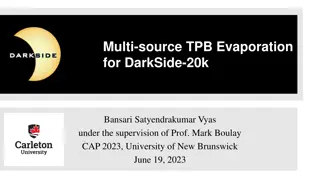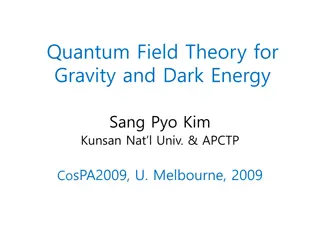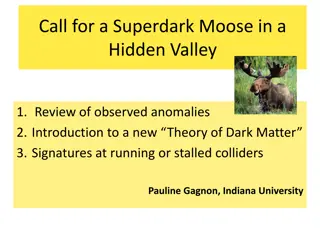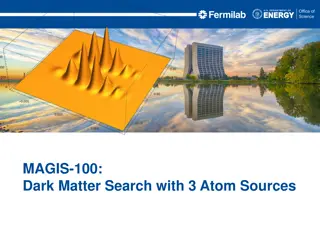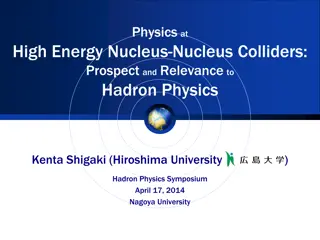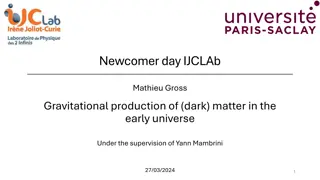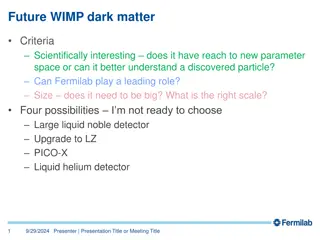Exploring the Mysteries of Dark Matter and SuperWIMPs
Dark matter, detected only gravitationally, poses enigmatic characteristics and poses challenges in direct detection. Scientists search for interactions with particles, explore hypothetical undetectable forms, and consider production mechanisms. SuperWIMPs like NLSP and NLK decay into Dark Matter, known as SuperWIMPs. The quest for understanding Dark Matter continues with diverse astrophysical effects and theoretical inventions.
Download Presentation

Please find below an Image/Link to download the presentation.
The content on the website is provided AS IS for your information and personal use only. It may not be sold, licensed, or shared on other websites without obtaining consent from the author. Download presentation by click this link. If you encounter any issues during the download, it is possible that the publisher has removed the file from their server.
E N D
Presentation Transcript
290E Seminar SuperWIMPs Nicolas Ferland December 2nd2015 1
What are the characteristics of Dark Matter It has not been detected otherwise than gravitationally. Its density stopped evolving in the early universe in an amount slightly higher than the baryonic asymmetry. That is, it has not decay in large amount since then. 2
What are we searching when we say we are searching for Dark Matter We are trying to observe its interaction with nuclei or photons to understand which particles is Dark Matter. We are trying to produce a particle in collider experiment which seems to have the stability, the mass and the cross section needed to be Dark Matter. We are trying to observe other astronomic effect which impose more constrains on Dark matter like its decay product, tiny lensing effect, Supernovae cooling, or destruction of white dwarf. 3
Are we sure that Dark Matter can be directly detected? No ! There is no guarantee that Dark Matter interacts otherwise than gravitationally or that these interactions are strong enough to be distinguished of neutrinos. We don t know if the Dark Matter particles are big enough so that an individual particle can be gravitationally detected. 4
Can theorists invent Dark Matter which are not directly detectable? Yes The gravitino predict by supergravity is likely to be the lightest superpartner, so to be Dark Matter and it interacts only gravitationally. The Kaluza-Klein graviton, which exist if there is an extra-dimension which forms a loop. 5
How those particles could have been produced? Those particles could have been produced thermically by quantum gravity, but it is generally believed that all particles produced by quantum gravity have been diluted by inflation and that the post-inflation temperature was way bellow the Planck scale. Those particles can be produced by the decay of a particle which can decay only by them: Next lightest supersymmetric partner (NLSP) Next lightest KK particle (NLK) 6
In this scenario, the NLSP and the NLK are WIMPs but they have all decayed long ago. Dark Matter is their decay, it s a SuperWIMP. The WIMPs can be thermically produced. Then it decays over a long time, the decay being suppressed by the Planck scale but they all ends to be SuperWIMPs so the thermal relic density is preserved. 7
How Dark Matter can have been produced Freeze out: Dark Matter was in equilibrium with the Standard Model particles until the temperature be bellow its mass. Then Dark Matter becomes Standard Model particles exponentially until it s suppressed by the universe expansion. Final concentration is inversely proportional to the cross section. Non-thermic: Dark Matter has been produced by inflaton decay or other phenomena without relationship to the Standard Model temperature. The cross section with Standard Model particles must be negligible. Freeze in: Dark Matter has been produced thermically but has always been under the equilibrium density. Its decay with itself has always been negligible. Final concentration is directly proportional to the cross section. It also depends on the time to produced it which depends on the mass and the maximal temperature after inflation. 8
The top of the overclosure region is the freeze-out which produced exactly the good amount of Dark Matter : < v> = 2.10-26 cm s-1There is also a logarithmic dependence on the mass. The left side of overclosure region is the freeze-in which produced exactly the good amount of Dark Matter All colored region are excluded for thermal production. TRis the maximum temperature after inflation, BXis the branching ratio of inflation decay to Dark Matter. Freeze-out is independent of these parameters. 9
Why thermal relic is interesting In a thermal relic model, both Dark Matter and baryon density are the photon density multiply by a small constant which could be similar. In other explanation must find another way to relates the Dark Matter density to the Baryonic density. The freeze-out boundary pass through the electroweak mass scale at the weak coupling constant. 10
Is it experimentally testable in collider The WIMPs can be produced in collider. In fact, to observe a particle which seems stable and whose cross section and mass would have made it having the good relic density but which is not directly detected would be a very good indication of the SuperWIMPs. 11
Can we observe it by astronomic effect? The decay of WIMPs to SuperWIMPs produce Standard Model particles. Constrains from the Cosmic Microwave background and the Nucleosynthesis forbid any kind of hadronic by-product and put limit on electromagnetic by-product. 12
Nucleosynthesis The same ratio baryon-to-photon is computed with CMB and deuterium. Other elements have consistent results but not the lithium 7. The lack of lithium 7 could be explained by decay of WIMPs in electromagnetic particles. 13
CMB CMB seems to be an exact Planck distribution. Decay of WIMPs into SuperWIMPs would change this distribution by increasing the energy of the photons more than their number. In equilibrium, the photon chemical potential is 0. The decay of WIMPs would increase it. The constrain is: < 9.10-5 It constrains the WIMPs lifetime (< 107s) and the amount of released electromagnetic energy. 14
Conclusion SuperWIMPs cannot be directly detected but their model has observational consequences for collider experiments, nucleosynthesis and CMB analysis. SuperWIMPs can be naturally produced with a density similar to baryonic matter. As WIMP Dark Matter is mostly excluded by direct detection, it s time to search for other things. 15
References Jonathan L. Feng, Arvind Rajaraman, and Fumihiro Takayama. SuperWIMP Dark Matter Signals from the Early Universe. arXiv:hep- ph/0306024v2 11 Aug 2003 P. S. Bhupal Dev, Anupam Mazumdar, and Saleh Qutubb. Constraining Non-thermal and Thermal properties of Dark Matter. arXiv:1311.5297v2 [hep-ph] 9 May 2014 JONATHAN L. FENG, ARVIND RAJARAMAN, BRYAN T. SMITH, SHUFANG SU, FUMIHIRO TAKAYAMA. SuperWIMP Cosmology and Collider Physics. arXiv:hep-ph/0410178v1 12 Oct 2004 16




